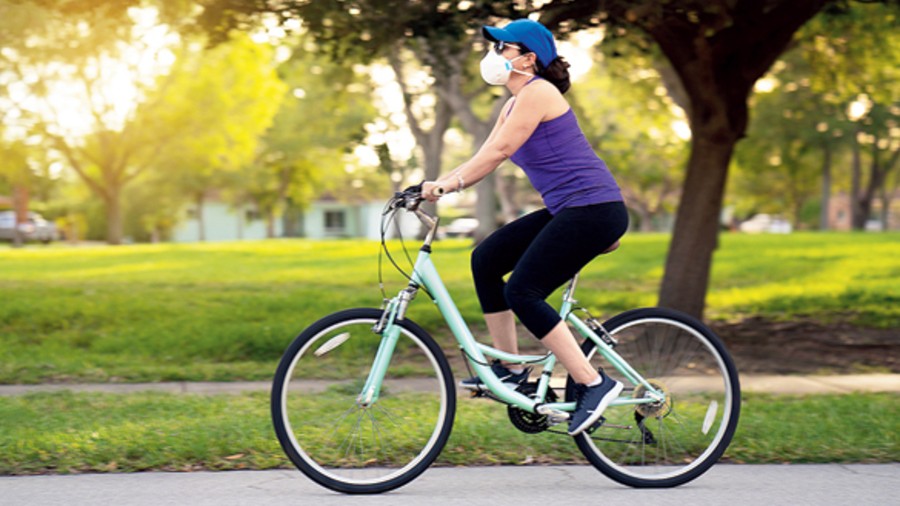There are many benefits to cycling, especially if you can do it on open fields. Let’s look at the advantages of cycling in general and then how indoor cycling can be equally intense, providing a good workout.
Overall, cycling offers cardiovascular as well as muscular endurance. Since it siphons off undue tension from the joints, the two-wheeler can be a great equipment for anyone looking for an effective workout. It can be a workout by itself or can be paired with another exercise.
Benefits of cycling
• The light two-wheeler can get one sweating profusely and the heart racing, proving to offer the perfect cardiovascular workout.
• Since balancing the cycle is crucial, it works the core and strengthens stability. Core muscles include those in the abdominal region as well as the back. Strengthening of core muscles not only balances one’s centre of gravity, but also helps the spine. The slight forward lean while cycling elongates the spine.
• Cycling keeps the joints mobilised without exerting unwanted pressure on the knees. Cycling is not predominantly a weight-bearing exercise. Being seated takes off much of the weight, transferring it to the gluteal muscles which can withstand weight. The rotational movement of cycles mobilises hip sockets, knees and ankles, allowing free movement of joints and promotes the full range of motions of the joints.
• Endurance is the body’s ability to sustain an extended period of workout. Cardiovascular endurance is the capability of the heart to pump blood. Breathing endurance is the capability of the lungs to provide oxygen to the blood. And muscular endurance is the ability of the muscles to work for an extended period. It has been shown that cycling improves one’s endurance as opposed to simply increasing the heart rate. Muscles are strengthened due to the constant use of quadriceps, hamstrings, gluteal muscles and calf muscles. Working the lower body to its optimum efficiency has proved beneficial to the overall well-being as it comprises large muscles that primarily bear the body’s weight. The inherent resistance in a cycling programme naturally promotes muscle strengthening. Muscles being leaner than fat, they boost metabolism. In other words, more the muscles, lesser the fat and greater one’s overall health.
• Cycling works on one’s posture. A small percentage of the body’s weight is borne by the shoulders, providing the natural resistance it needs for strengthening, without exerting undue tension on the upper body joints, such as the neck. Cycling, for a considerable amount of time, will define the shoulders and make the muscles surrounding it strong.
• Cycling is not solely beneficial from a physical point of view. It improves navigational skills as it incorporates ascending and descending slopped landscape, controlled movement at turns, being cautious of potholes, and saving one’s self from surrounding traffic.
In case you like indoor cycling

Sourced by the correspondent
• Indoor cycling can be combined with resistance training, involving the kettlebell, barbell, dumb-bell and/or body weight exercises. It can form a part of the circuit training which enhances the innate benefits of cycling. For example, a circuit comprising a minute of cycling alternated with pull-up or predominantly an upper-body exercise will be an optimum set, making the workout intense.
• Indoor cycling makes good use of one’s time. Most stationary cycles have features to increase resistance, enforcing one to put in extra effort to get the wheels rotating, strengthening the muscles and melting fat. Benefits of such a workout, especially if combined with resistance training, can be availed in a shorter time period, as opposed to an hour-long cycling session on natural terrain.
• Indeed you shall not be deterred by nature’s wrath! The roof above an indoor cycle is a blessing during the months of summer and monsoon.
• Uneven terrain with many potholes can dampen the enthusiasm of a novice cyclist. The indoor cycle provides stability, allowing room for consistency, which is very crucial for a beginner to build confidence.
• Indoor cycling is advisable for people with weak back, shoulder, ankles and/or knees. The stable ground on which the cycle firmly rests, absorbs most of the shocks, opposed to the frequent jerks on natural land, which can be detrimental to people with physical challenges.
• The stationary feat of the cycle allows one to work on posture and pedal work, due to the stable ground on which it is placed. It also allows the flow needed for a good workout, contrary to being paused on account of vehicles or pedestrians. These cycles are made with the intent to exercise. It makes workout routines efficient.
Anwar Wahhab is a metabolic analytic practitioner and strength and conditioning coach











